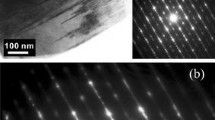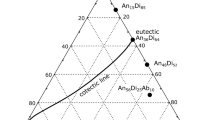Abstract
Annealing experiments on natural olivine (Mg1-x Fe x )2SiO4 (with x≈0.11) crystals (San Carlos, Arizona, spinel-lherzolite context) have been performed between T=1,100° C and 1,500° C for oxygen partial pressures pO2=10−3 to 10−13 bar and times of 1 to 140 h in CO/CO2 or H2/H2O gas mixtures. Even specimens annealed within the T-pO2 theoretical stability field (TSF) calculated for stoichiometric olivine (Nitsan 1974) show systematic alterations developed within the first few microns of the surface of the crystals. Pyroxene crystals or melt form on the original olivine surface even at T=1,100° C, with preference of pyroxene when T<1,350° C and SiO2-rich glass if T>1,350° C. This glass (rhyolite-like) can concentrate calcium from the starting olivine, and aluminum when Cr-Al spinels are present as inclusions. These observations are in contradiction with the TSF. They are obviously due to the presence of platinum used as a container of our samples, even if the contact between olivine and platinum is very weak. Rapid surficial diffusion of iron toward platinum (or via the gas phase) induces a Fe-depleted surface. According to the TSF, this more forsteritic surface should have a wider pO2 range of stability. This is not the case, just because this situation is largely out of equilibrium. This iron loss induces a departure from cationic stoichiometry: (Mg, Fe)2(1−δ), SiO4 with δ small and positive. We extended the model that Nakamura and Schmalzried (1983) (N.S.) developed for fayalite (x=1) to our natural olivine composition, under the assumption that the majority defects are magnesium vacancies, Fe3+ occupying octahedral and tetrahedral sites, and the more complex neutral defect corresponding to Coulombic attraction between neighboring Fe3+ ions. We have recalculated the olivine stability field in pO2 vs. δ space at T=1,300° C using this model for x≈0.1 (its extreme limit of validity) and conclude that olivine is stable only in a very narrow range in pO2 which depends on δ. The calculation shows also that when olivine has nearly cationic stoichiometry (δ=0) as we believe for our starting material, the pO2 range of stability is narrower than indicated by the TSF. In particular, it explains why Fe precipitates from the olivine (δ=0) (in absence of any other precipitation of SiO2-rich phases) between 10−11 and 10−13 bar at 1,300° C; this was not predicted by the TSF. Magnetite or iron precipitates also coexist with SiO2-rich exsolutions or pyroxene when pO2 is close to the upper or lower boundaries of the TSF, respectively. The N.S. model may have important implications for the interpretation of the existence of partial melting and/or the low-viscosity/low velocity zone in the upper mantle.
Similar content being viewed by others
References
Berkhemer H (1980) High-temperature anelasticity and elasticity of mantle peridotite-reply. Phys Earth Planet Inter 23:235
Berkhemer H, Auer F, Drisler J (1979) High temperature anelasticity and elasticity of mantle peridotite. Phys Earth Planet Inter 20:48–59
Boland JN, Duba AG (1981) Solid state reduction of iron in olivine-planetary and meteoritic evolution. Nature 294:142–144
Boland JN, Duba AG (1985) Defect mechanisms for the solid-state reduction of olivine. In: Point defects in minerals, Schock RN (ed). American Geophysical Union Monograph, A.G.U., Washington DC, pp 211–225
Boland JN, Duba AG (1986) An electron microscope study of the stability field and degree of non stoichiometry in olivine. J Geophys Res 91:4711–4722
Bowen NL, Schairer JF (1935) The system MgO-FeO-SiO2. Am J Sci 5th Ser 24:151–217
Champness PE (1970) Nucleation and growth of iron oxides in olivines (Mg, Fe)2SiO4. Mineral Mag 37:790–800
Cooper RF, Kohlstedt DL (1982) Interfacial energies in the olivine-basalt system. In: Adv Earth Planet Sci, High pressure research in geophysics, Akimoto and Manghani (eds) 12:217–228
Darot M, Gueguen Y (1981) High-temperature creep of forsterite single crystals. J Geophys Res 86:6219–6234
Duba AG, Boland JN (1984) Reduction and nonstoichiometry of olivine. EOS Trans Am Geophys Union 65 no 45:1091
Durham WB, Goetze C (1977) Plastic flow of oriented single crystals of olivine. I: Mechanical data. J Geophys Res 82:5737–5753
Durham WB, Goetze C, Blake B (1977) Plastic flow of oriented single crystals of olivine. II: Observation and interpretation of the dislocation structure. J Geophys Res 82:5755–5765
Durham WB, Froidevaux C, Jaoul O (1979) Transient and steady-state creep of pure forsterite at low stress. Phys Earth Planet Inter 19:263–274
Frey AF, Prinz M (1978) Ultramafic inclusions from San Carlos, Arizona: petrological and geochemical data bearing on their petrogenesis. Earth Planet Sci Lett 38:129–176
Giddings RA, Gordon RS (1973) Review of oxygen activities and phase boundaries in wüstite as determined by EMF and gravimetric method. J Amer Ceram Soc 56:111–116
Grove TL (1981) Use of Fe Pt alloys to eliminate the Iron loss problem in 1 atmosphere gas mixing experiment. Theoretical and practical considerations. Contrib Mineral Petrol 78:298–304
Gueguen Y, Darot M (1980) High-temperature anelasticity and elasticity of mantle peridotite-comments. Phys Earth Planet Inter 23:232–234
Ito K, Kennedy GC (1967) Melting and Phase relation in a natural peridotite to 40 Kilobars. Am J Sci 265:519–538
Jaoul O, Froidevaux C, Durham WB, Michaut M (1980) Oxygen self-diffusion in forsterite: Implications for the high temperature creep mechanism. Earth Planet Sci Lett 47:391–397
Jaoul O, Poumellec M, Froidevaux C, Havette A (1981) Silicon diffusion in forsterite: A new constraint for understanding mantle deformation. In: Stacey FD, Paterson MS, Nicolas A (eds) Anelasticity in the Earth, Geodyn Ser 4 AGU Washington DC, pp 95–100
Jaoul O, Houlier B, Abel F (1983) Study of 18O diffusion in magnesium orthosilicate by nuclear microanalysis. J Geophys Res 88:613–624
Jaques AL, Green DH (1979) Determination of liquid compositions in high-pressure melting of peridotite. Am Mineral 64:1312–1321
Jaques AL, Green DH (1980) Anhydrous melting of peridotite at 0–15 Kb Pressure and the Genesis of Tholeitic Basalts. Contrib Mineral Petrol 73:287–310
Johnston AD, Stout JH (1984) Development of orthopyroxene-Fe/Mg ferrite symplectites by continuous olivine oxidation. Contrib Mineral Petrol 88:196–202
Karato S, Sato H (1982) Effect of the oxygen partial pressure on the dislocation recovery in olivine: a new constraint on creep mechanisms. Phys Earth Planet Inter 28:312–319
Kirby SH, Wegner ML (1978) Dislocation substructure of mantlederived olivine as revealed by selective chemical etching and transmission electron microscopy. Phys Chem Minerals 3:309–330
Kohlstedt DL, Nichols HPK, Hornack P (1980) The effect of pressure on the rate of dislocation recovery in olivine. J Geophys Res 85:3122–3130
Kohlstedt DL, Hornack P (1981) Effect of oxygen partial pressure on the creep of olivine. In: Stacey FD, Paterson MS, Nicolas A (eds), Anelasticity in the Earth, Geodyn Ser 4 AGU Washington DC, pp 101–107
Kohlstedt DL, Mackwell SJ (1985) Stability of San Carlos olivine. Trans Am Geophys Union, EOS 66:1084
Kohlstedt DL, Ricoult D (1984) High temperature creep of silicate olivines. In: Deformation of ceramics II, Tressler RE, Bradt RC (eds). Plenum Publishing Corporation, pp 251–280
Kröger FA, Vink HJ (1956) In: Solid State Physics Advances in Research and Applications, Seitz F, Turnbull D (eds). Academic Press, New York, pp 307–435
L'Hoir A, Schmaus D, Cawley J, Jaoul O (1981) Depth profiling light nuclei in single crystals: a combined nuclear reaction and R.B.S. technique to minimize unwanted channeling effects. Nucl Instrum Methods 115:357–366
Medaris LG Jr (1969) Partitioning of Fe2+ and Mg2+ between coexisting synthetic olivine and orthopyroxene. Am J Sci 267:945–968
Merrill RB, Wyllie PJ (1973) Absorption of iron by platinum capsules in high pressure rock melting experiments. Am Mineral 58:16–20
Michaut M (1981) Etude du fluage de la forsterite et de l'olivine monocristallines. Thèse Université Paris-Sud, 91405 Orsay, France
Mosely D (1984) Symplectic exsolution in olivine. Am Mineral 69:139–153
Nakamura A, Schmalzried H (1983) On the nonstoichiometry and point defects of olivine. Phys Chem Minerals 10:27–37
Nakamura A, Schmalzried H (1984) On the Fe2+-Mg2+ interdiffusion in olivine. Ber Bunsenges Phys Chem 88:140–145
Nitsan U (1974) Stability field of olivine with respect to oxidation and reduction. J Geophys Res 79:706–711
Paquet J, Dhamelincourt P (1984) Analyse par microsonde moléculaire Raman et microsonde électronique des verres et des inclusions de très petite taille d'un xénolithe acide. Bull Minéral 107:619–626
Philibert J (1985) Diffusion et transport de matière dans les solides. Les Editions de Physiques, 91944 Les Ulis, France, p 472
Pluschkell W, Engell HJ (1968) Ionen und Elektronenleitung in Magnesium Orthosilikat. Ber Dtsch Keram Ges 45:388
Poumellec B (1981) Fugacité d'oxygène et déformation plastique de l'olivine à haute température. Thèse Université Paris-Sud, 91405 Orsay, France
Poumellec B, Jaoul O (1984) Influence of pO2 and pH2O on the high temperature plasticity of olivine. In: Deformation of ceramics II, Tressler RE, Bradt RC (eds). Plenum Publishing Corporation, pp 281–305
Rizzo HF, Gordon RS, Cutler IB (1969) Determination of phase boundaries and thermodynamic functions in the iron-oxygen system by EMF measurements. J Electrochem Soc 116:266–274
Roeder PL, Emslie RF (1970) Olivine-liquid equilibrium. Contrib Mineral Petrol 29:275–289
Rog G, Borchardt G (1984) Study of the solubility of silica in forsterite by solid state EMF measurements. J Electrochem Soc 131:380–384
Schock RN, Duba AG (1985) Point defects and the mechanisms of electrical conduction in olivine. In: Point defects in minerals, Schock RN (ed). AGU, Washington DC, pp 88–96
Taylor RW, Muan A (1962) Activities of iron-platinum alloys at 1,300° C. Trans T MS — AIME 224:500–502
Williams RJ (1972) Activity-composition relations in the fayalite-forsterite solid solution between 900° and 1,300° C at low pressures. Earth Planet Sci Lett 15:296–300
Author information
Authors and Affiliations
Rights and permissions
About this article
Cite this article
Jaoul, O., Houlier, B., Cheraghmakani, M. et al. Surface destabilization and laboratory-induced non-stoichiometry in San Carlos olivine. Phys Chem Minerals 15, 41–53 (1987). https://doi.org/10.1007/BF00307607
Received:
Issue Date:
DOI: https://doi.org/10.1007/BF00307607




